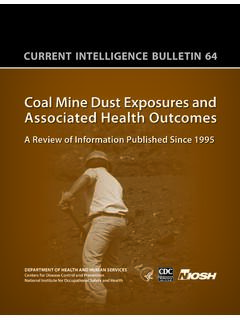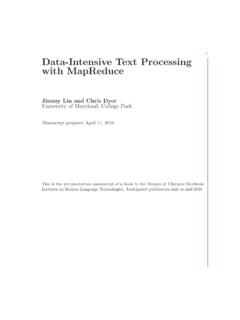Transcription of Data Mining - Bibliothek
1 data Mining Practical Machine Learning Tools and Techniques Third Edition Ian H. Witten Eibe Frank Mark A. Hall AMSTERDAM BOSTON HEIDELBERG LONDON. NEW YORK OXFORD PARIS SAN DIEGO. SAN FRANCISCO SINGAPORE SYDNEY TOKYO M<. Morgan Kaufmann Publishers is an imprint of Elsevier Contents LIST OF FIGURES xv LIST OF TABLES xix PREFACE xxi Updated and Revised Content xxv Second Edition xxv Third Edition xxvi ACKNOWLEDGMENTS xxix ABOUT THE AUTHORS xxxiii PART I INTRODUCTION TO data Mining . CHAPTER 1 What's It All About? 3. data Mining and Machine Learning 3. Describing Structural Patterns 5.
2 Machine Learning 7. data Mining 8. Simple Examples: The Weather Problem and Others 9. The Weather Problem 9. Contact Lenses: An Idealized Problem 12. Irises: A Classic Numeric Dataset 13. CPU Performance: Introducing Numeric Prediction 15. Labor Negotiations: A More Realistic Example 15. Soybean Classification: A Classic Machine Learning 19. Fielded Applications 21. Web Mining 21. Decisions Involving Judgment 22. Screening Images 23. Load Forecasting 24. Diagnosis 25. Marketing and Sales 26. Other Applications 27. Machine Learning and Statistics 28. Generalization as Search 29.
3 data Mining and Ethics 33. Reidentification 33. Using Personal Information 34. Wider Issues 35. Further Reading 36. VI Contents CHAPTER 2 Input: Concepts, Instances, and Attributes 39. What's a Concept? 40. What's in an Example? 42. Relations 43. Other Example Types 46. What's in an Attribute? 49. Preparing the Input 51. Gathering the data Together 51. ARFF Format 52. Sparse data 56. Attribute Types 56. Missing Values 58. Inaccurate Values 59. Getting to Know Your data 60. Further Reading 60. CHAPTER 3 Output: Knowledge Representation 61. Tables 61. Linear Models 62.
4 Trees 64. Rules 67. Classification Rules 69. Association Rules 72. Rules with Exceptions 73. More Expressive Rules 75. Instance-Based Representation 78. Clusters 81. Further Reading 83. CHAPTER 4 Algorithms: The Basic Methods 85. Inferring Rudimentary Rules 86. Missing Values and Numeric Attributes 87. Discussion 89. Statistical Modeling 90. Missing Values and Numeric Attributes 94. Naive Bayes for Document Classification 97. Discussion 99. Divide-and-Conquer: Constructing Decision Trees 99. Calculating Information 103. Highly Branching Attributes 105. Discussion 107.
5 Contents vii Covering Algorithms: Constructing Rules 108. Rules versus Trees 109. A Simple Covering Algorithm 110. Rules versus Decision Lists 115. Mining Association Rules 116. Item Sets 116. Association Rules 119. Generating Rules Efficiently 122. Discussion 123. Linear Models 124. Numeric Prediction: Linear Regression 124. Linear Classification: Logistic Regression 125. Linear Classification Using the Perceptron 127. Linear Classification Using Winnow 129. Instance-Based Learning 131. Distance Function 131. Finding Nearest Neighbors Efficiently 132. Discussion 137.
6 Clustering 138. Iterative Distance-Based Clustering 139. Faster Distance Calculations 139. Discussion 141. Multi-Instance Learning 141. Aggregating the Input 142. Aggregating the Output 142. Discussion 142. Further Reading 143. Weka Implementations 145. CHAPTER 5 Credibility: Evaluating What's Been Learned 147. Training and Testing 148. Predicting Performance 150. Cross-Validation 152. Other Estimates 154. Leave-One-Out Cross-Validation 154. The Bootstrap 155. Comparing data Mining Schemes 156. Predicting Probabilities 159. Quadratic Loss Function 160. Informational Loss Function 161.
7 Discussion 162. viii Contents Counting the Cost 163. Cost-Sensitive Classification 166. Cost-Sensitive Learning 167. Lift Charts 168. ROC Curves 172. Recall-Precision Curves 174. Discussion 175. Cost Curves 177. Evaluating Numeric Prediction 180. Minimum Description Length Principle 183. Applying the MDL Principle to Clustering 186. Further Reading 187. PART II ADVANCED data Mining . CHAPTER 6 Implementations: Real Machine Learning Schemes 191. Decision Trees 192. Numeric Attributes 193. Missing Values 194. Pruning 195. Estimating Error Rates 197. Complexity of Decision Tree Induction 199.
8 From Trees to Rules 200. : Choices and Options 201. Cost-Complexity Pruning 202. Discussion 202. Classification Rules 203. Criteria for Choosing Tests 203. Missing Values, Numeric Attributes 204. Generating Good Rules 205. Using Global Optimization 208. Obtaining Rules from Partial Decision Trees 208. Rules with Exceptions 212. Discussion 215. Association Rules 216. Building a Frequent-Pattern Tree 216. Finding Large Item Sets 219. Discussion 222. Extending Linear Models 223. Maximum-Margin Hyperplane 224. Nonlinear Class Boundaries 226. Contents ix Support Vector Regression 227.
9 Kernel Ridge Regression 229. Kernel Perceptron 231. Multilayer Perceptrons 232. Radial Basis Function Networks 241. Stochastic Gradient Descent 242. Discussion 243. Instance-Based Learning 244. Reducing the Number of Exemplars 245. Pruning Noisy Exemplars 245. Weighting Attributes 246. Generalizing Exemplars 247. Distance Functions for Generalized Exemplars 248. Generalized Distance Functions 249. Discussion 250. Numeric Prediction with Local Linear Models 251. Model Trees 252. Building the Tree 253. Pruning the Tree 253. Nominal Attributes 254. Missing Values 254.
10 Pseudocode for Model Tree Induction 255. Rules from Model Trees 259. Locally Weighted Linear Regression 259. Discussion 261. Bayesian Networks 261. Making Predictions 262. Learning Bayesian Networks 266. Specific Algorithms 268. data Structures for Fast Learning 270. Discussion 273. Clustering 273. Choosing the Number of Clusters 274. Hierarchical Clustering 274. Example of Hierarchical Clustering 276. Incremental Clustering 279. Category Utility 284. Probability-Based Clustering 285. The EM Algorithm 287. Extending the Mixture Model 289. Contents Bayesian Clustering 290.






